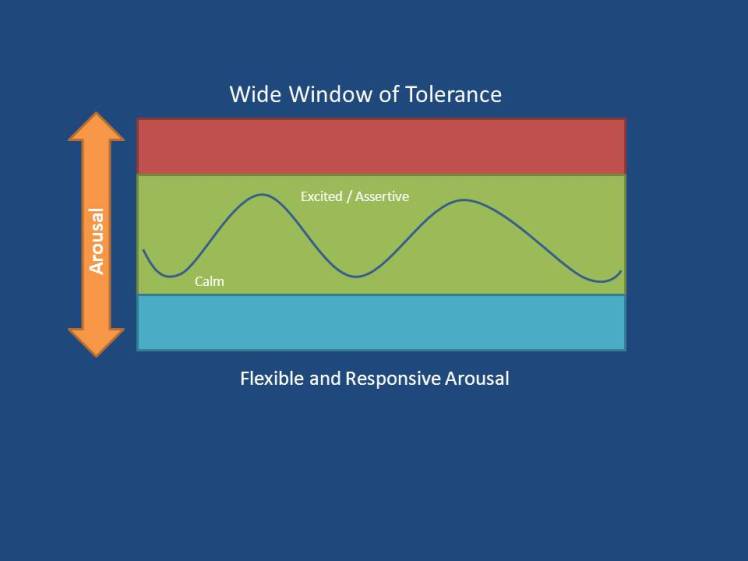So much of resilience comes from the ability to create a good response to what happens in the world around us, instead of allowing the more primitive parts of our brains to take over and react with fight-flight-or-freeze. Dr.s Tina Payne Bryson and Dan Siegel provide two different ways we can visualize our brain-states (or “nervous system arousal.”) The first is “The Green Zone” or the “Window of Tolerance.” When we are calm and alert, in the green zone, we can access all the logical and thinking parts of our brain. We can listen, process information, use our memories, and learn new things. This “window of tolerance” is the best state in which to make decisions. We can consider our options, and be reasonable, social, and responsible. We can respond. When our nervous system is triggered into high alert by something like anger, anxiety, frustration, or fear, we can head out of the window of tolerance into the red zone. There we can only access what we need for safety and survival – fighting (or becoming defensive,) fleeing (or actively avoiding,) or freezing (physically or mentally.) We lose the ability to think well or logically. We feel overwhelmed, enraged, rigid, obsessive, or chaotic. We react. We may say or do things we wish we hadn’t. The blue zone represents a state of under-arousal, such as shutting down, becoming apathetic or depressed, disconnecting, or dissociating. Both the red zone and the blue zone are states of dysregulation. Children who are dysregulated are not very able to listen or learn. They need to get back into their green zone first. They often need soothing, or sensory supports, or strategies to calm down.
When we are calm and alert, in the green zone, we can access all the logical and thinking parts of our brain. We can listen, process information, use our memories, and learn new things. This “window of tolerance” is the best state in which to make decisions. We can consider our options, and be reasonable, social, and responsible. We can respond. When our nervous system is triggered into high alert by something like anger, anxiety, frustration, or fear, we can head out of the window of tolerance into the red zone. There we can only access what we need for safety and survival – fighting (or becoming defensive,) fleeing (or actively avoiding,) or freezing (physically or mentally.) We lose the ability to think well or logically. We feel overwhelmed, enraged, rigid, obsessive, or chaotic. We react. We may say or do things we wish we hadn’t. The blue zone represents a state of under-arousal, such as shutting down, becoming apathetic or depressed, disconnecting, or dissociating. Both the red zone and the blue zone are states of dysregulation. Children who are dysregulated are not very able to listen or learn. They need to get back into their green zone first. They often need soothing, or sensory supports, or strategies to calm down.
Some of us have a wide window of tolerance, and handle a great deal of stress, sadness, or frustration without it triggering dysregulation. Some of us have more reactivity. Our green zone is smaller, and we head into the red or blue zones with only a small amount of emotion or stress. We can widen our green zones with mindful practice. The window of tolerance expands the more we become aware of it, the more we become aware of when we are in or out of it, and the more we patiently practice returning to it when we become dysregulated.
Notice when you and your child are approaching the limits of your window of tolerance. Notice when you cross the threshold. If you have a reactive child, help her learn about her green zone, and develop some soothing strategies with her so she can practice returning to it again and again.

Great post!
LikeLike
Thanks, Brandi! Can’t wait to see your book.
LikeLike
I just did a Google search for Bryson zones and your blog popped up! Cool! This is an excellent post, my friend!
LikeLike
That is great! Thanks, Kay.
LikeLike